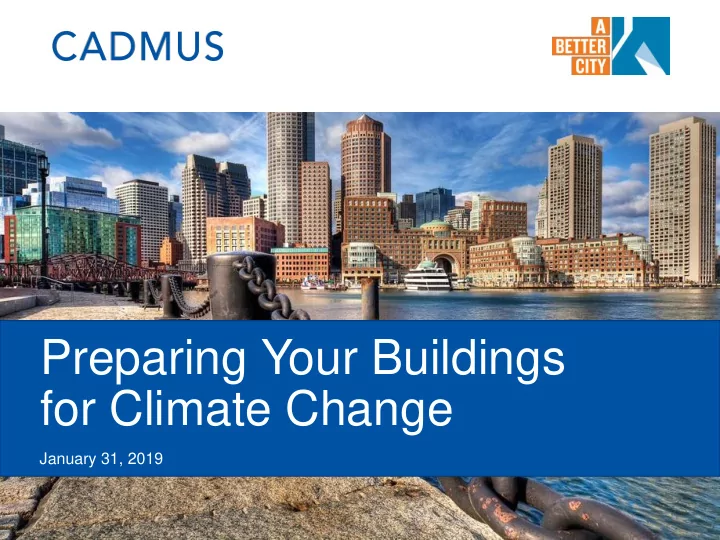

Preparing Your Buildings for Climate Change January 31, 2019
Agenda Template Presentation Discussion 2
Template Presentation
Project Overview • Audience: Commercial real estate property owners and managers considering resilience at the building-level • Primary focus is existing buildings and their daily operations • Can inform risk planning for new construction or major rehabilitation projects • Contents: Existing best practice climate resilience resources and includes new guidance for decision-making and implementation • Geography: Focus on Boston, MA • Project Partners: Boston Green Ribbon Commission’s Commercial Real Estate Working Group (GRC CREWG), A Better City (ABC), and Cadmus 4
Project Components • Template, Worksheet and Vendor List 5
Planning Process 6
Step 1 – Create an Internal Team Recommended Team Members • Action Steps Energy Manager • Determine representatives Maintenance and Operations staff from each relevant Grounds keeping & custodial staff department • Assign roles and Security Manager responsibilities Finance staff • Communicate with team Sustainability Manager Communications staff Personnel or tenant engagement staff 7
Step 2 – Identify Climate Risks Climate Factor Summary • Rate of increase is accelerating Extreme Heat • Number of days with extreme heat will increase • 20 – 40 days over 90 and 5 days over 100 by 2030 • Heat waves will be hotter, last longer, and occur with greater frequency • Pace of SLR is accelerating Sea Level Rise • Additional 8” above 2000 levels by 2030 • Northeast experiencing greater increase in precipitation than Extreme anywhere else in the country Precipitation • 24- hour storm of 5.5” by 2035, greater than the Boston stormwater drainage system is designed to handle Sources: Climate Ready Boston, BPDA Climate Resiliency Guidance 8
Step 2 – Identify Climate Risks • Resources • Climate Ready Boston Map Explorer • BPDA Zoning Viewer • Resilient MA Climate Clearing House Climate Ready Boston Explorer • Action Steps • Determine exposure to extreme heat • Determine exposure to sea level rise • Determine exposure to extreme precipitation • Determine exposure to storm surge BPDA Zoning Viewer 9
Discussion • Have you used any of these tools in your work? • Do you have any questions about these tools? 10
Step 3 – Establish a Property Baseline • Key Considerations • Site characteristics • Building characteristics • Existing resiliency efforts • Resources • BPDA Climate Resiliency Guidelines and Checklist • Action Steps • Collect relevant information • Develop property baseline • Identify gaps in information, collect additional material, add them to property baseline • Assess role for third-party vendors to assist in developing a property baseline 11
Step 4 – Conduct Vulnerability Analysis • Resources • US Climate Resilience Toolkit • Action Steps • Determine exposure of each building asset • Determine vulnerability of each building asset • Determine risks • Assess role for third-party vendors in conducting a vulnerability analysis Probability of a loss > Relative Risk Low Medium High Very High Magnitude of (potential) loss > U.S. Climate Resilience Toolkit Risk Matrix: Risk Characterization 12
Step 5 – Research Solutions • Resources • ABC’s Building Resilience Toolkit • BPDA Climate Resiliency Design Reference Guide for New Developments • Action Steps • Research solution for reach vulnerable asset identified during vulnerability analysis • Review case studies where additional information is desired • Assess role for third-party vendors in researching and determining solutions 13
Discussion • Do these steps resonate with your experience? • Establish a property baseline • Conduct vulnerability assessment • Research solutions 14
Concluding Steps • Step 6: Prioritize Strategies • Determine priority of action based on ability to minimize probability or magnitude of risk • Determine expected value of prioritized actions based on associated costs and benefits • Step 7: Identify Financing and Incentives • Create budget assessment of prioritized actions • Track funding opportunities 15
Concluding Steps Continued • Step 8: Create an Implementation Plan • Determine timeline for each priority action • Determine lead for each priority action • Determine budget source for each priority action • Consider existing organizational processes that should be revised • Step 9: Implement, Evaluate and Communicate • Communicate with internal team to evaluate progress • Update plans as necessary • Share resilience plans internally and externally 16
Discussion Subheading
Discussion • What is your initial reaction to the template and worksheet? • How do you envision using the template, worksheet, and/or vendor list? 18
Pilot Project • In 2019 ABC will be working with a small group of members to pilot the Resilience Template process • Participants will receive 1:1 or Working Group support from ABC • Would you consider being a part of this pilot? • What goals would you have for this process? 19
Thank You / Q&A
Recommend
More recommend